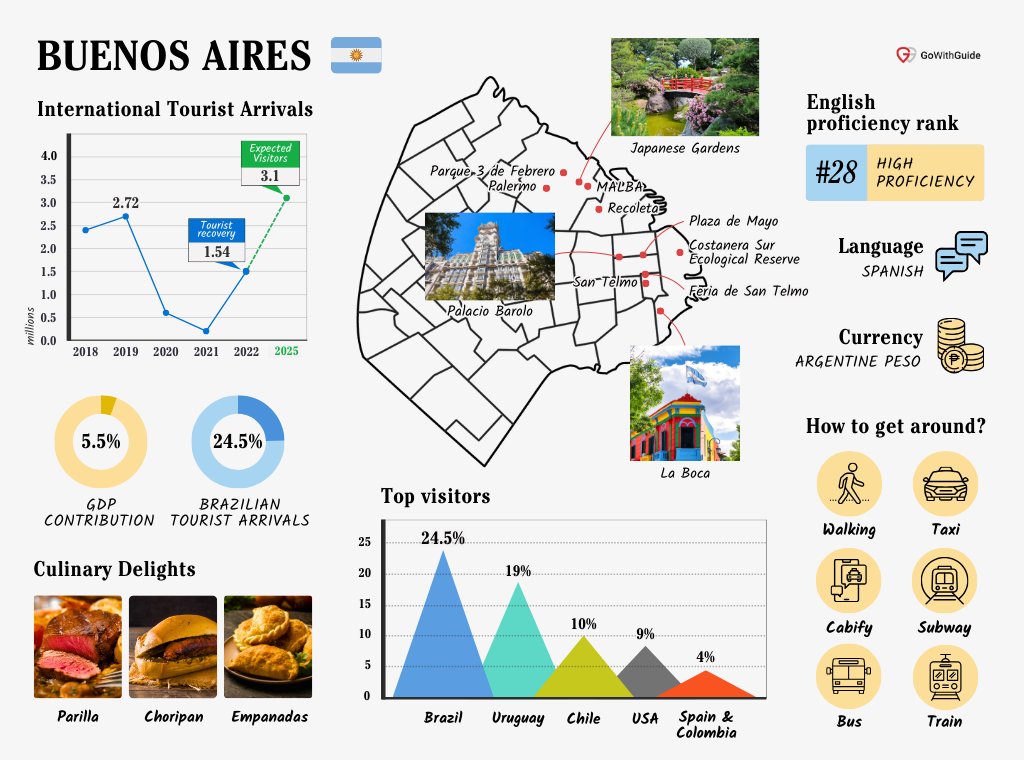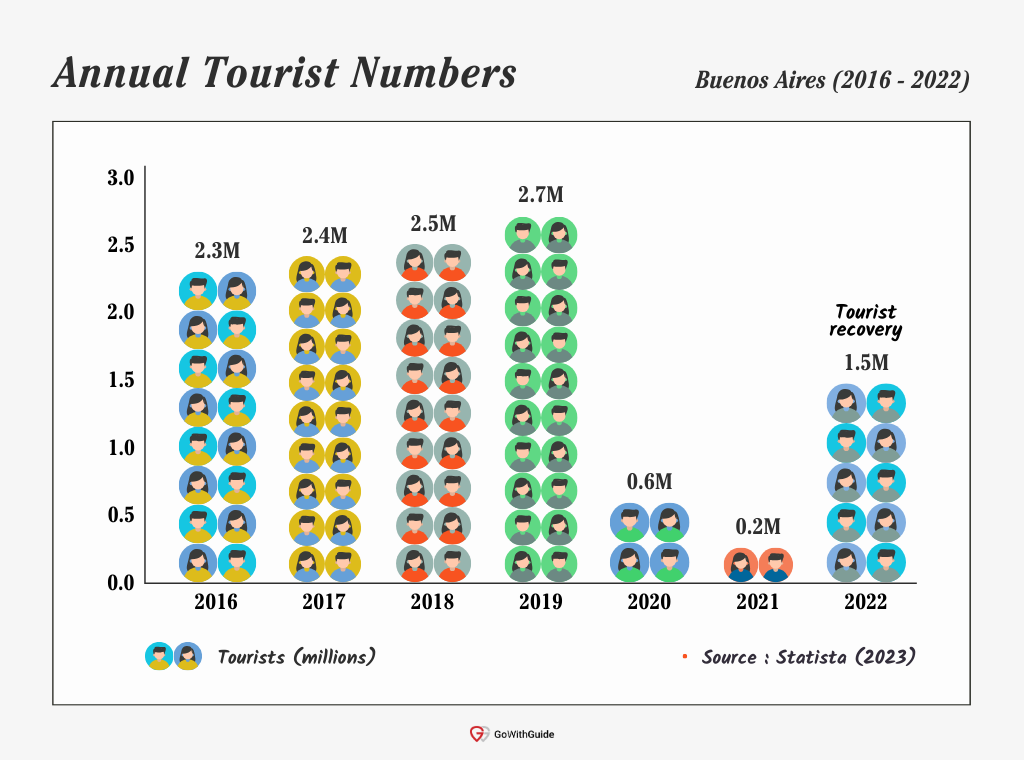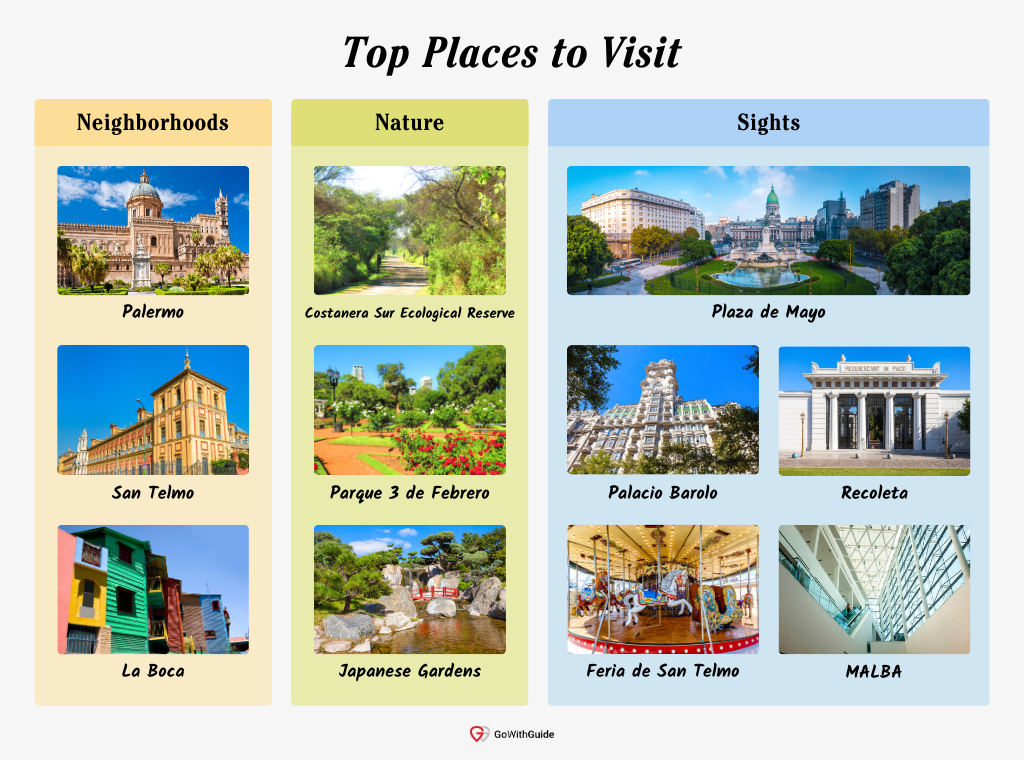Have you visited Paris? What about the ‘Paris of the South?’ Welcome to the enchanting world of Buenos Aires, where tango rhythms pulse through the streets and the aroma of sizzling steak beckons from every corner alongside lively murals adorning the city's walls.
The European-style architecture, wide boulevards and artistic flair make it a must-see city when you’re in this region of the world. But what makes Buenos Aires so special? This article tackles that very topic, from yearly visitors, to “dos & don'ts”, and when to consult a Buenos Aires tour guide, so let’s make like Maradona and go!
Buenos Aires Travel Guide: Unveiling the Beauty of Argentina’s Capital

The population of the Buenos Aires province is estimated to be 17,569,053 according to the INDEC national statistics bureau during the 2022 census, with 52% being female and 48% being male. Around 15% of the population was over 59 years old. In terms of demographics, most of the population is of a European descent, the most common being Italian and Spanish.
So, how many tourists visit Buenos Aires each year? Full 2023 numbers haven’t been published yet, but for the five years before that, the number of international tourists visiting Buenos Aires through airport arrival was:

-
2018: 2.47m
-
2019: 2.72m
-
2020: 0.63m
-
2021: 0.02m
-
2022: 1.54m
It’s exciting to see that after the pandemic’s lull, Buenos Aires is reclaiming its status as a tourism hotspot, drawing in 1.5 million visitors in 2022.
Of this, Buenos Aires travel statistics by country show that the top countries that visited Buenos Aires were:
-
Brazil (24.5%)
-
Uruguay (19%)
-
Chile (10%)
-
United States (9%)
-
Spain and Colombia (both over 4%)
In terms of tourism in Buenos Aires, tourists generally stay for an average of six nights, with the majority (77%) staying in hotels. So is tourism big in Argentina? Yes! With 84% of visitors enjoying the city's museums and cultural scene, while 64% of visitors are there for the food and 37% are there for the lively bars and nightlife.
Buenos Aires In 2024 And Beyond
In 2019, the Travel and Tourism sector significantly contributed to the city's GDP, constituting 5.5% of the total economy, equivalent to US$11 billion. However, the sector experienced a sharp decline of over 47% in 2020. Despite this setback, they bounced back, with recovery from 2021 onwards. In 2022, the tourism sector's contribution to GDP rebounded to nearly 5%, amounting to US$7.4 billion.
Overall, Buenos Aires emerges as one of Latin America's leading cities in terms of tourism recovery. Despite the challenges posed by the global pandemic, Buenos Aires surpassed its 2019 tourism levels and consolidated its status as one of Argentina's top tourism destinations in 2022 and by 2025, it’s estimated that Buenos Aires will attract around 3.1 million international tourists. But what about the specific place visitors are going when in the city? Let’s look at those!
Buenos Aires Tourism Quick Stats
-
2.72m - The number of international visitors that landed via air in Buenos Aires in 2019
-
1.54m - The recovery number of international tourists that visited Buenos Aires in 2022
-
5.5% - the percentage that Buenos Aires’s tourism and travel industry contributed to the overall GDP
-
3.1m - The international visitors expected to tour Buenos Aires in 2025
-
24.5% - The percentage of Brazilians who visited Buenos Aires, the city’s largest group of foreign tourists.
Buenos Aires Tourist Attractions: Top Places to Visit
To help you get started with your itinerary, let’s go through some tourist attractions in Buenos Aires that might intrigue you enough to add them to your list, and to help you answer that one question, ‘Why is Buenos Aires a popular tourist destination?’ These neighborhoods, nature and sights are a great place to start.

Neighborhoods
-
Palermo: A bustling recreational hub with the city's largest parks, diverse ethnic restaurants and fashion outlets. Notable attractions include the Jardín Botánico with 5,000 flower species and the Buenos Aires Japanese Gardens, the largest in South America.
-
San Telmo: Known for its colorful streets and colonial-style buildings, it’s a charming district popular for cafés, tango parlors and boutique shops. The National Historical Museum and the Bernardino Rivadavia Natural Sciences Museum are also here.
-
La Boca: This vibrant neighborhood is favored by artists who decorate balconies and patios with sculptures. The Caminito Street Museum offers a colorful pedestrian zone with crafts, souvenirs and tango demonstrations, while the Quinquela Martín Museum of Fine Arts showcases works by notable 20th-century Argentinian artists.
Nature
-
Costanera Sur Ecological Reserve: A scenic waterfront reserve with rental kiosks along the promenade, ideal for picnics, walks and birdwatching. Over 300 bird species can be spotted, and the eastern shoreline provides a serene view of the Río de la Plata rocky shores.
-
Parque 3 de Febrero: Palermo's expansive park, formerly the private retreat of a 19th-century dictator, now offers various activities such as jogging, power walking and picnics. Landmarks include El Jardín de los Poetas and the beautiful Rosedal.
-
Japanese Gardens: Inaugurated in 1967, these serene gardens in Buenos Aires feature carefully designed elements for balance and harmony, including diverse plants, a koi pond and Japanese culture-inspired sculptures. Adjacent to Tres de Febrero park, it includes a cultural center, Japanese restaurant, craft shop and a nursery for purchasing bonsai trees and plants.
Sights
-
Plaza de Mayo: Buenos Aires' oldest public square is a historic site central to key events like the 1810 uprising. It's an ideal starting point for exploring the city, featuring landmarks such as Casa Rosada, Avenida de Mayo and the iconic Café Tortoni.
-
Recoleta: Named after a 1716 convent, Recoleta is famous for its elaborate cemetery, including mausoleums for notable figures like Eva Perón. The area reflects Argentina's cultural emphasis on death, with crypts symbolizing ongoing celebrations. Check out the gardens, cafés and attractions like the Museo de Arte Hispano-Americano Isaac Fernández Blanco and the National Library.
-
MALBA: The Latin American Art Museum of Buenos Aires is a modern hub showcasing works by contemporary Latin American artists. This world-class museum in its stunning building also serves as a cultural center, emphasizing the country's film and visual arts.
-
Palacio Barolo: Explore this striking building’s lobby, enjoy guided tours, vintage elevator rides and panoramic rooftop views through Palacio Barolo Tours, featuring thematic tours and a new cocktail bar and café, Salón 1923, on the 16th floor.
-
Feria de San Telmo: On Sundays, San Telmo's main street transforms into a vibrant pedestrian zone with craft stalls, juice vendors and captivating street performances by tango artists. It's an ideal spot for unique local souvenirs, but be cautious in the bustling crowd.
So, from this list, what’s Buenos Aires known for? It’s culture, arts, architecture, community and delicious food. Speaking of food, what should you eat while there?
Culinary Delights: A Foodie’s Journey Through Buenos Aires
There are certain foods that you must try while in Argentina, but while in Buenos Aires, what are some foods to keep an eye on? Well, we’ve got you covered, so jot these down!

-
Argentine Steak (Parilla): Argentine cuisine emphasizes beef, with popular choices like Sirloin served in various dining spots. Steakhouses, known as Parrillas, offer both casual and upscale options, with each steak usually accompanied by chimichurri, a flavorful mix of spices, red wine vinegar, olive oil and parsley.
-
Choripan: As popular fast food in Buenos Aires, Choripan features sausages made from beef, pork or lamb. The classic version is topped with chimichurri, but there are various other toppings available.
-
Empanadas: The most prevalent fast food in Buenos Aires, Empanadas are widely available in different variations. Beef empanadas, with ground beef, onions and green olives, are popular, along with options like shredded chicken and vegetarian choices such as spinach/cheese, onions/cheese, grilled vegetables and creamed corn.
-
Locro: A beloved dish originating from the Andes regions, Locro is cherished in Argentina and neighboring countries. Ingredients include pumpkin, yams, hominy, beans, chorizo and various cuts of pork or beef, with slight regional variations.
-
Dulce De Leche: A luscious, caramelized sauce made by slowly heating milk and sugar, Dulce de Leche is ubiquitous in Buenos Aires and commonly used in various desserts.
-
Alfajor: A sweet treat often enjoyed as a snack or with breakfast, Alfajores feature a crumbly cookie filled with dulce de leche. Available at cafés like Havana or traditional Kioskos, popular brands include Jorgito, Vaquita and Blanco y Negro.
-
Yerba maté: Maté tea, with a slightly bitter and earthy flavor, is commonly shared among friends or family, sipped from the same gourd passed around.
Seasonal Delights: Best Time to Visit Buenos Aires
Buenos Aires, situated in a humid subtropical climate with no dry season, experiences distinct seasons throughout the year.

Summer (December to February): The city gets warm temperatures, peaking in January, with highs ranging from 20oC (68oF) to 30oC (86oF). Summer is characterized by intense showers and thunderstorms, making it the wettest season, with an average rainfall of 350mm (13.8in).
Autumn (March to May): There’s a gradual decline in temperatures, transitioning from comfortable in March to cool to cold in May. Rainfall varies, with March being the rainiest month at around 145mm (5.7in) and May being the driest at approximately 80mm (3.15in). Light frosts occur in May nights.
Winter (June to August): The city experiences cooler temperatures, with July being the coldest month. Temperatures range between 8oC (46.4oF) and 15oC (59oF) in July. While snowfall is extremely rare, sporadic rain is common, and June is the cloudiest month with only 4 hours of sunshine per day.
Spring (September to November): Temperatures rise, with September still relatively cool, October featuring cool temperatures and November being comfortably warm. Wet days increase from around 7 in September to 10 in October and November, with September being the windiest month.
The best time to visit Buenos Aires is during spring when the weather is pleasantly warm. Autumn is also great, with fading summer heat and trees displaying shades of orange and yellow. Winters are chilly, gray and rainy, while summers are warm and humid, attracting tourists during the high season in December to February. The low season in winter offers affordability and fewer crowds.
Festivals and Events: Timing Your Visit for The Ultimate Experience
It’s always important to think about the season you’re traveling in, and to consider planning your trip around the seasons, but also for the events that occur during those seasons, so here are a few that might pique your interest:
-
International Tango Festival: Join thousands of tango dancers in August in the birthplace of tango! This two-week event has free concerts, classes, milongas and so much more!
-
Ciudad Emergente Festival: Every September, Buenos Aires’ up-and-coming talent show off their music, photography, film, comedy, poetry and dance, so there’s something to entertain everyone.
-
Matear: Held in August, this free fair brings together family businesses and Yerba maté companies who showcase their unique flavors of the drink.
-
Night of the Ice Cream Parlors: Hundreds of ice cream parlors around the city offer discounts on their ice cream, with 2024’s festivities held on November 9 from 7pm.
Transportation in Buenos Aires: Getting Around the City Efficiently
So, you’re in Buenos Aires for your activity-filled trip, but how do you get around?
You may be asking yourself, ‘Is Buenos Aires a walkable city?’ The answer is yes, especially since Buenos Aires has often been termed one of the world’s most walkable cities, making Buenos Aires very tourist friendly! Many tourist areas in Buenos Aires can be reached simply by letting your feet guide you while following a map on your phone.
If it’s not the greatest weather or need to get somewhere slightly further, though, there are plenty of other options for getting around Buenos Aires. Let’s go through them.
-
Walking: Convenient for city center landmarks and neighborhoods like Recoleta and Palermo.
-
Cabify: Widely used alternatives for point-to-point travel; download the app, but bring some cash in case your card fails you.
-
Taxi: Radio Taxi, the official taxi service, is available for street hailing; be prepared with cash, and drivers may speak only Spanish.
-
Subway (el Subte): This system comprises six lines covering most areas. You will need a SUBE Card, which you can buy and charge at kiosks or subway stations. You will need your passport to get one.
-
Local Buses: Extensive coverage but can be challenging; stick your arm out to signal to the bus to stop for you, hop on and tell the driver which street you want to get off and tap the SUBE card. Use Google Maps to help you get around.
-
Trains: Blue trains connect different city points and province areas; useful for day trips, like to Tigre Delta.
You can also take a bike tour through the city or surrounding areas. Check out a range of fun full- or half-day private tours in Buenos Aires to break up your trip!
Safety and Etiquette: Essential Tips for a Smooth Visit to Buenos Aires
Buenos Aires travel safety isn’t much different from other safety measures you would take when traveling around the world. In terms of Buenos Aires crime statistics, Buenos Aires has a crime safety rating of 63.43 and a safety index of 36.57. The most common crimes in the city are robberies and petty thefts.
Let’s go over some tips and tricks that will help you throughout your trip, both in terms of safety and in having a seamless visit.
Dos & Don’ts For Travelers In Buenos Aires

Do:
-
Take a tango class, please! - Don’t be concerned with how you’ll look as you learn how to dance. Tango is directly linked to this city, so try out your moves with a fun, instructed class.
-
Be smart and stay vigilant - Just like you would when traveling anywhere in the world. Though mostly safe, tourists can be a target for petty theft.
-
Taxi Talk - Tell your taxi driver the two streets that intersect for where you want to be dropped off, don’t tell them the exact location as this can cause confusion, especially since some drivers don’t speak much English.
-
Learn some basic Spanish - It will be a cool way to interact with locals, and understand some of the Spanish menus in restaurants.
Don’t:
-
Don’t Use Uber (which is actually illegal in Argentina, but still operates) - Use Cabify, as it’s generally cheaper anyway.
-
Don’t Visit La Boca At Night - as it’s a rougher neighborhood when dark.
-
Don’t Be Flashy With What You Wear - Keep a low profile, as you wouldn’t want to lose any valuables while touring.
-
Don’t Expect Gluten-free Options On Menus - and speaking of restaurants, Argentinians eat late, like 10:30pm and later! So don’t arrive too early.
Conclusion
Your trip to Buenos Aires awaits you! In the meantime, why not check out the various private tours you could take while there, or check out the wide range of Buenos Aires tour guides available for you to customize your trip? See you there!
